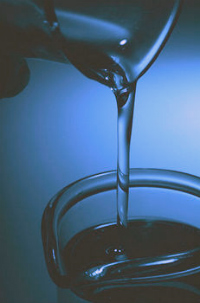Surfactant-based ionic liquids: Phenol extractants for water
ionic liquid extractants

ionic liquids are coming into their own as extractants for a range of compounds due to their high thermal stability, very low volatility and green characteristics. These properties are a direct result of their composition, typically cations based on imidazolium or phosphonium salts and anions such as [BF4]_ and [PF6]_.
A more recent development has been the introduction of surfactant groups into ionic liquids to increase the interaction between aqueous phases and the ionic liquids, thereby improving the extraction efficiency. However, to be useful as extraction solvents they must also be immiscible with water, otherwise subsequent phase separation is virtually impossible.
This approach has been adopted by scientists based at Louisiana State University in the USA, led by Isiah Warner, who have designed a series of surfactant-based ionic liquids that are poorly water-soluble aimed at extracting phenol pollutants from environmental water. Writing in Electrophoresis, they described how they used capillary electrophoresis to separate the phenols from the ionic liquids for their determination by diode array detection.
Surfactant components
Four of the ionic liquids shared dioctylsulfosuccinate [AOT] as the anion, paired with tetrabutylphosphonium [4C4P], tetrabutylammonium [4C4N], trihexyltetradecylphosphonium [3C6PC14] or 1-methyl-3-octylimidazolium cations. The fifth was trihexyltetradecylphosphonium dodecylsulfate [3C6PC14][SDS]. They were all viscous liquids with densities of 0.82-0.9 mg/mL.
They were tested for the extraction of a series of phenols, including phenol itself, the three mononitrophenols, 3-chlorophenol and 2,4-dichlorophenol, which were dissolved in water. After mixing with the aqueous solutions, the phenol-enriched ionic liquids were collected by centrifugation and diluted with acetonitrile for direct injection into the CE system for analysis.
The electropherograms of [3C6PC14][AOT] and [3C6PC14][SDS] displayed unexpected new peaks, baseline shifts and lengthened retention times. This was attributed to lower dissolution efficiencies of the phenols due to their higher hydrophobicities and viscosities that are caused by the longer alkyl chain lengths. A higher proportion of acetonitrile countered these effects but hampered separation of the phenols, so these two ionic liquids were rejected. The extractant based on 1-methyl-3-octylimidazolium ions was also rejected because it introduced a large peak in the electropherogram that interfered with the phenol peaks.
That left [4C4P][AOT] and [4C4N][AOT] which produced comparable electropherograms to those achieved with standard solutions of the phenols alone. Of these two, the former was selected for closer examination because it provided better distribution ratios and extraction efficiencies. Following optimisation of factors such as the extraction time, sample pH and sample volume, CE detection limits of 0.047-0.257 µg/mL were achieved for the phenols.
Enviromental success
The good results prompted the team to test local lake and river water samples for the presence of phenols but none were found. Instead, they spiked the samples with known amounts of phenols then used [4C4P][AOT] to extract them.
The recoveries of all of the phenols were greater than 90% and the CE sensitivity was also increased by a factor of 100%. These results illustrate the excellent performance of the ionic liquid, demonstrating that inclusion of a surfactant group in the formulation has a positive effect on the extraction process.
The presence of the surfactant also ensures that the ionic liquid is easily separated from the water phase and can be injected directly into the CE system, unlike the many common types of ionic liquid which are miscible with water. With an extraction time of 12 minutes, [4C4P][AOT] is a promising extractant to screen for the presence of phenols in environmental waters.
